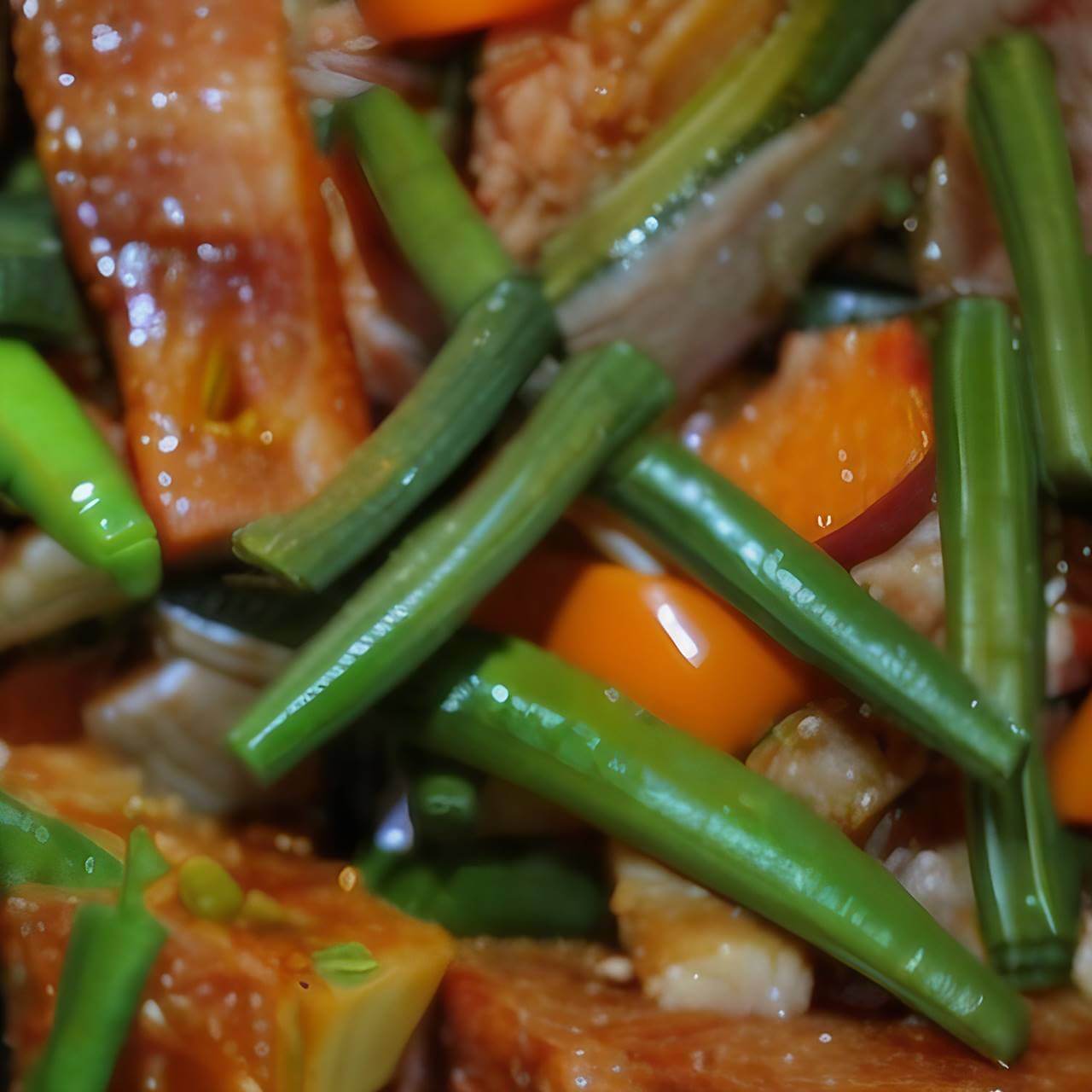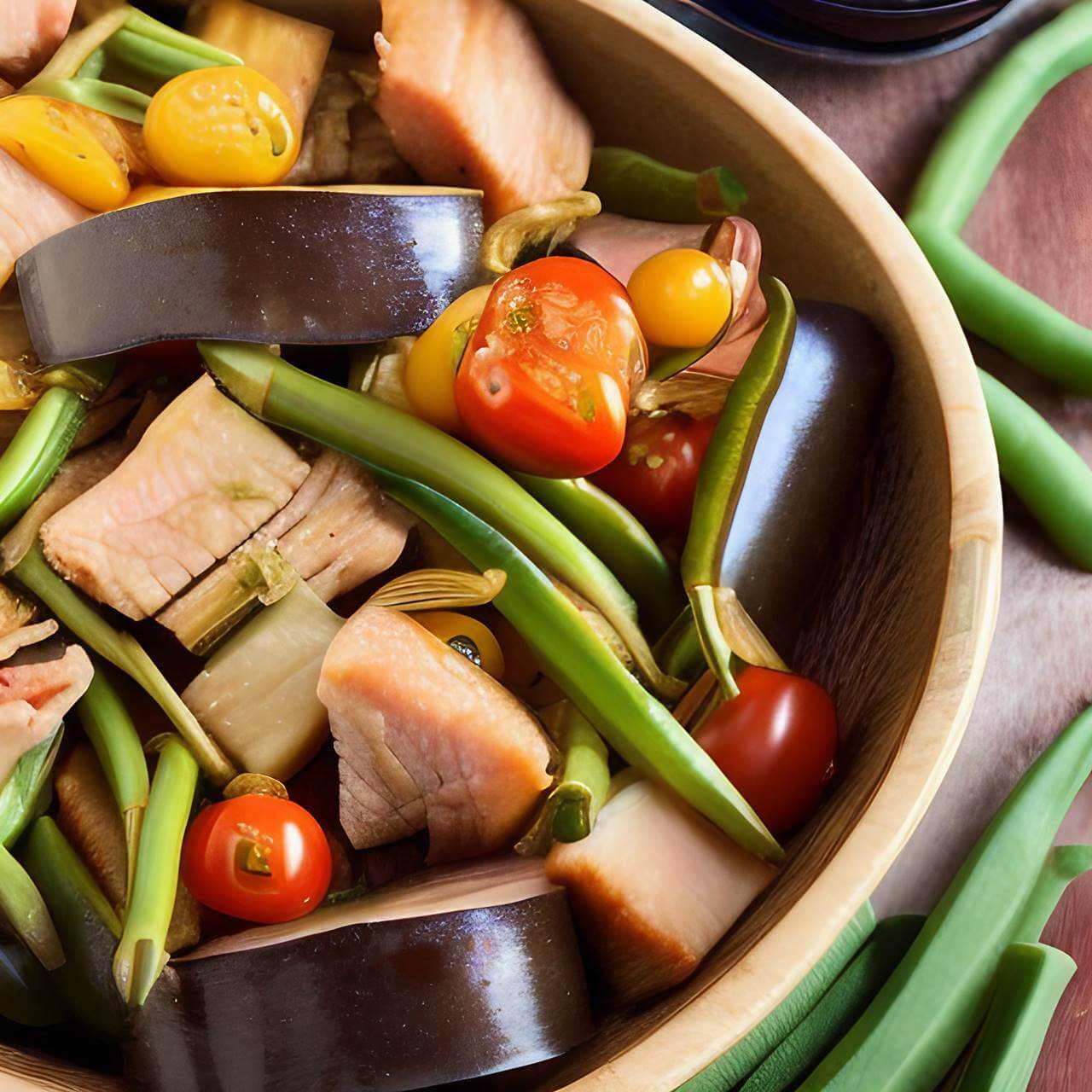Pinakbet or Pakbet, a vegetable stew from Ilocos in the Philippines, is named after the Ilocano term ‘pinakebbet’ which means “shriveled”. This alludes to how vegetables are slow-cooked over low heat until they become much smaller due to sweating.
Drawing from local staples, the dish is comprised of root crops and beans such as okra, ginger, tomatoes, eggplant, ampalaya, sitaw, siling, duwag and kamote. Its unique flavor is derived from bagoong monamon – a seasoning made up of fermented fish. To complete this delectable combination diced pork or bagnet with shrimp or pre-cooked fish for extra zest!
Also Read: How to Cook Filipino Pork Menudo
Pinakbet Tagalog tantalizes the taste buds as much as it nourishes your body. Its vivid combination of local vegetables, pork belly, and shrimp paste makes this classic Filipino dish a perfect accompaniment to fried fish or grilled meat – or served on its own for an elevated main entree. Let’s be honest – many of us have memories from our childhoods of actively avoiding this vegetable-based dish in favor of something more palatable to our taste buds – like fried chicken or breaded pork chops.
Some of my most cherished childhood recollections are the lunchtime feasts of our mother’s pinakbet. I’m sure, like many children, we would have much-preferred spaghetti or chicken bbq over this zesty vegetable stew if given a choice, yet still adoringly savored every bite as if it were a culinary delicacy!
Once you were older and experienced the taste, you recognized what an amazing dish it was. And after several memories of past experiences with this food, your appreciation for its popularity skyrocketed! There’s no denying that there must be a reason why this meal is so beloved.

Ingredients
- Cut 500 grams of pork belly into bite-sized pieces for easy serving.
- For a flavorful addition to your dish, add one chopped onion!
- Mince 4 cloves of garlic to prepare for use in your recipe.
- To add a delicious umami flavor to your dish, try using 2 tablespoons of either shrimp paste (bagoong alamang) or anchovy paste (bagoong isda). Either will do the trick and bring out the natural flavors in your meal!
- 2 pcs tomato, cut into cubes
- Cut a small-sized squash (kalabasa) into cubes, same with your sweet potato cut into bite size portion
- For a delectable dish, cut 8 pieces of okra into halves.
- Cut one bitter gourd (ampalaya) into thin slices.
- For this recipe, you will need one large-sized eggplant, cut into slices.
- Slice a small bunch of string beans into 2-inch pieces to prepare them for cooking.
- To make this recipe perfect, add two cups of room-temperature water.
- To give your dish an extra flavor boost, sauté with 2 Tablespoons of cooking oil.
- Season to perfection with salt and pepper.
Steps to Cook Pinakbet
- In a pot, heat your cooking oil and add in the onion and garlic. Saute these ingredients until they are fragrant before incorporating the ginger. Cook everything together until the onions become soft.
- Saute the lechon kawali for one minute to bring out its delicious flavors.
- Bring the water to a rolling boil, ensuring that it is well-circulated throughout.
- Enhance your dish with Knorr Shrimp Cube, then cover and cook over medium heat for 20 minutes.
- Mix in the tomato and bagoong alamang. Combining them, stir it before covering the pot tightly with its lid. Simmer for three minutes to bring out all of the flavors!
- Gently add the kalabasa or kamote to the pot before allowing it to simmer for 7 minutes.For a savory dish, combine sitaw, okra, ampalaya and eggplant. Once blended in the pot, stir the mixture and cover it for five minutes to cook.
- Generously season with ground black pepper and place the lechon kawali on top. Allow simmering for minutes before serving.
- Present your tasty creation on a beautiful platter, and indulge in its delightful flavors with loved ones. Bon Appétit!

Tips
- To guarantee that your dish is cooked evenly, make sure to cut the ingredients into uniform sizes; for example, long beans should be of equal length and pork belly should have matching thickness.
- Start with the vegetables that require more time to cook, such as kalabasa and sitaw. Then add eggplant, bittermelon, and okra which all need less cooking time for their texture to become tender.
- For optimal flavor and texture, pork belly is ideal for this recipe due to its balance of meat and fat. However, leaner cuts such as Boston butt are also workable choices in addition to proteins like bagnet or lechon kawali, shrimp, fried fish and grilled fish.
- With this recipe, pork belly was the best choice for its mouthwatering combination of fat and meat – ideal for Pinakbet Tagalog. But if you don’t care for pork, there are other cuts of pork that will work just as well!
- If you want a healthier version of the Pinakbet Tagalog, shrimp or other types of fish can be used instead of pork as your main ingredient.
- To reduce the fishy flavor, sauté the shrimp paste for a few minutes until it starts to darken. If you find the pinakbet too sour, add a pinch of sugar to balance out the flavors. Pinakbet is best enjoyed when paired with hot steamed rice! Enjoy your meal!
How to Serve and Store
- This Pinakbet Tagalog is a well-rounded and satiating combination of veggies and meat, making it the ideal meal all by itself. But if you are looking to pair it with something else, this Philippine classic goes wonderfully with fried fish or grilled proteins as well as white rice.
- Once the dish has cooled, transfer it to an airtight container to store and preserve its freshness. This delicious treat can be refrigerated for up to three days before enjoying it!
- For optimum heating results, use a pan with ample width and heat on medium until the contents are hot all the way through.
- Pinakbet Tagalog is best enjoyed while hot, so make sure to serve it immediately after heating! For a more flavorful and healthier version of this dish, consider adding in other vegetables such as squash, long beans, red bell peppers or carrots. Additionally, season the ingredients with Knorr Liquid Seasoning for an added layer of deliciousness
Frequently Asked Questions
1. What vegetables are best for Pinakbet Tagalog?
The most common vegetables used in this dish are kalabasa, okra, sitaw, bagoong alamang, tomato and eggplant. However, you can also add in other vegetables such as squash, long beans and carrots to make it more flavorful and healthier!
2. What type of pork is best for Pinakbet Tagalog?
Pork belly is the most common cut used when making this dish, due to its balance of fat and meat. However, leaner cuts such as Boston butt or bagnet can also be used in addition to proteins like lechon kawali, shrimp and fried fish.
3. How long can Pinakbet Tagalog be stored for?
Once the dish has cooled, transfer it to an airtight container and store in the refrigerator for up to three days before enjoying! For optimal heating results, use a pan with ample width and heat on medium until the contents are hot all the way through. Pinakbet Tagalog is best enjoyed while hot, so make sure to serve it immediately after heating!
4. How can I make my Pinakbet Tagalog healthier?
For a more flavorful and healthier version of this dish, consider adding in other vegetables such as squash, long beans, red bell peppers or carrots. Additionally, season the ingredients with Knorr Liquid Seasoning for an added layer of deliciousness. You can also use shrimp or other types of fish instead of pork as your main ingredient and sauté the shrimp paste for a few minutes until it starts to darken. If you find the pinakbet too sour, add a pinch of sugar to balance out the flavors. Enjoy your meal!
5. Can Pinakbet Tagalog be frozen?
While it is possible to freeze this dish for later use, the texture of the vegetables will not remain as enjoyable. We recommend consuming your Pinakbet Tagalog within three days after cooking and storing it in an airtight container in the refrigerator. Enjoy!

Summary
Pinakbet Tagalog is a well-rounded and satiating combination of veggies and meat that can be enjoyed all by itself. To make it more flavorful and healthier, consider adding in other vegetables such as squash, long beans, red bell peppers or carrots. Additionally, you could use shrimp or other types of fish instead of pork as your main ingredient to reduce the fishy flavor while sautéing the shrimp paste for a few minutes until it starts to darken.
For optimal heating results when serving this dish hot after refrigeration, use a pan with ample width and heat on medium until the contents are hot all the way through. Lastly, don’t forget to add Knorr Liquid Seasoning for an added layer of deliciousness! Enjoy your meal!